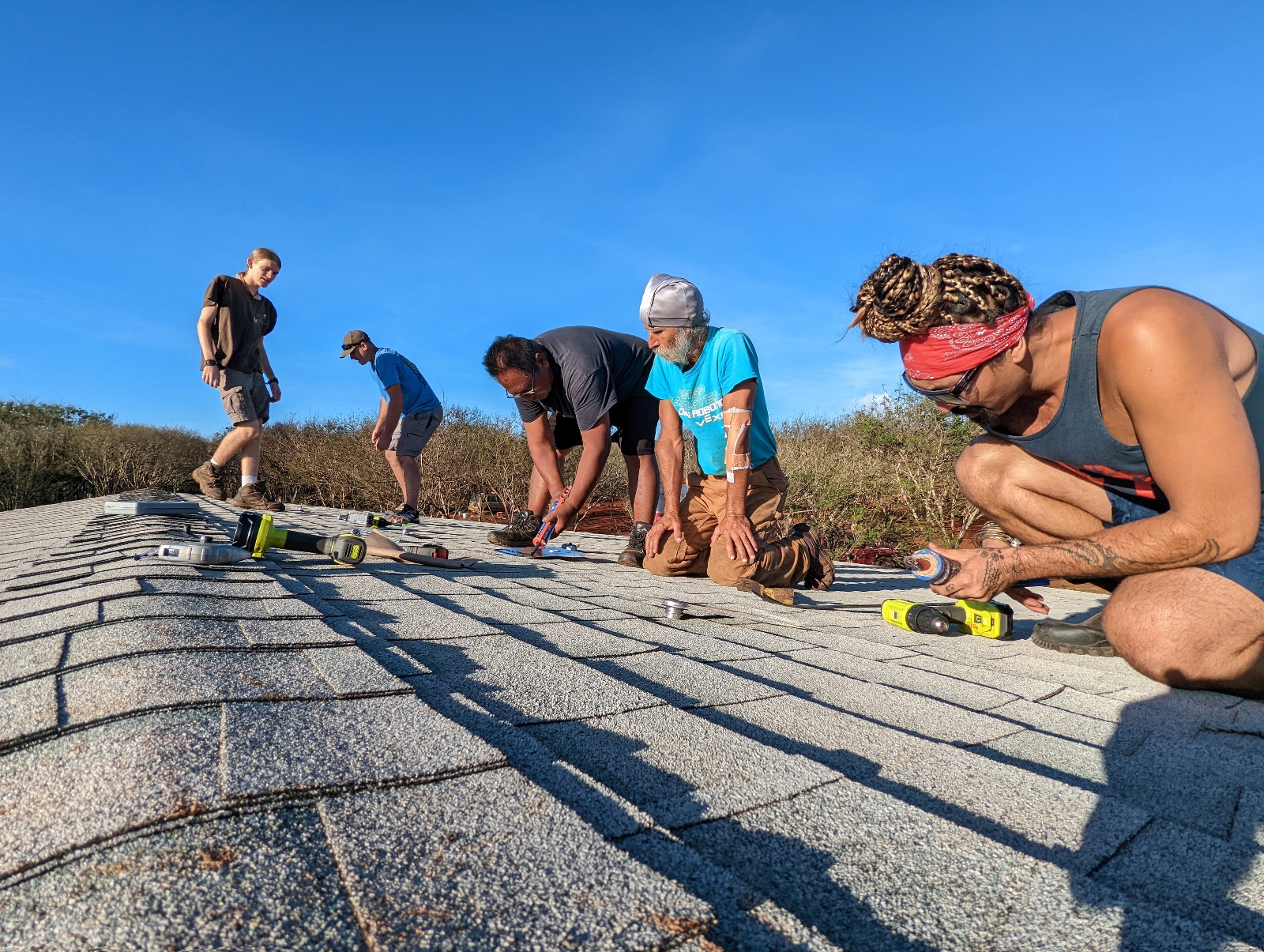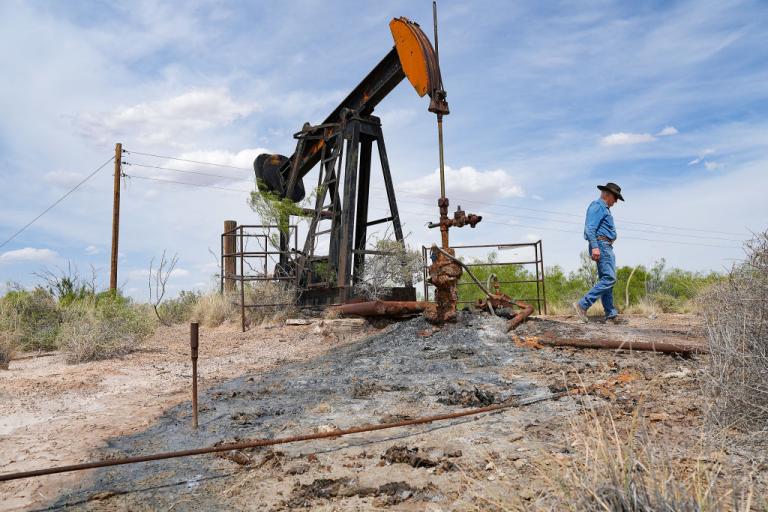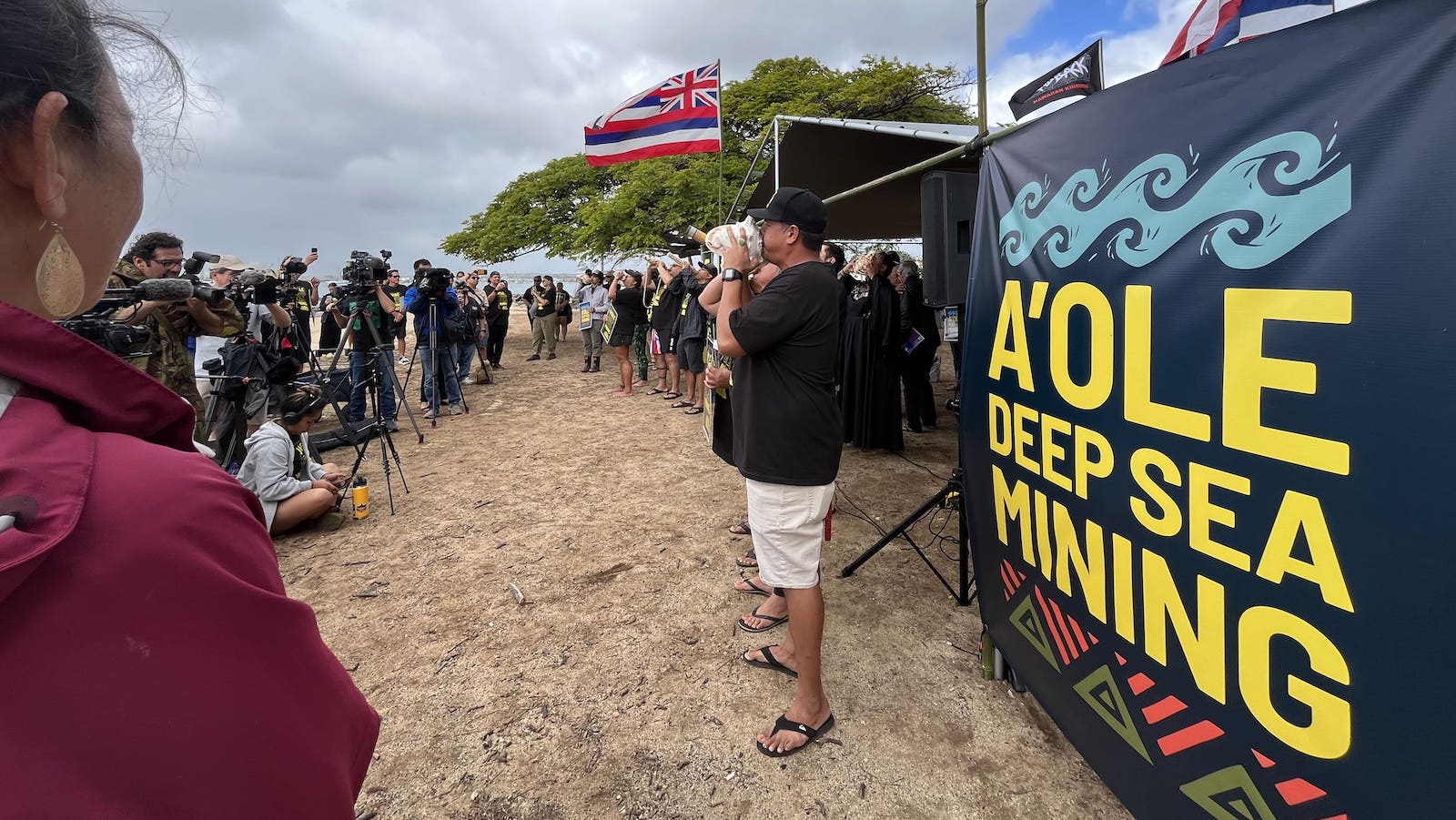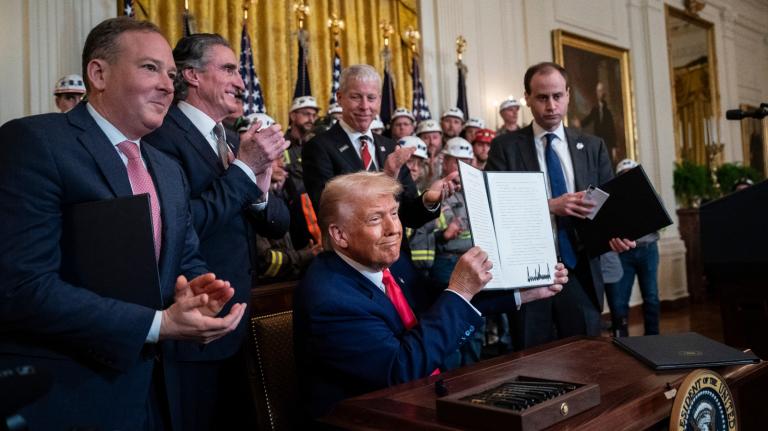Like many homesteaders on the island of Molokaʻi, Kailana Place grew up off-grid, on 40 acres of family land designated for Native Hawaiians. Living in repurposed school buses surrounded by fields of red volcanic clay and kiawe trees “was a glamping lifestyle,” joked the social worker and mother of three, a way of life powered by kerosene and propane.
Three years ago, those fuels sparked a devastating fire. Neighbors helped Place and her husband, Ikaika, build a new house with rooftop solar and a battery. Even now, the buzz of constant, reliable power has yet to wear off. Beyond ensuring continuous internet access and a freezer for fish and venison — most residents depend upon subsistence fishing, hunting, and farming — their asthmatic son no longer relies on a generator to power his inhaler. “It’s unreal,” said Ikaika Place. “My wife has never had a house where she could just switch on the lights.”
It’s been a radical change. When it comes to electricity, residents of Molokaʻi get by with as little as possible. Consumption rates on this rural island are the lowest in the Hawaiian Archipelago, and energy costs are the most expensive in the state, which pays the nation’s highest price per watt. For the 7,300 or so residents, that often means forgoing the luxury of reliable power. In fact, the cost and challenges of accessing utilities prompt many to live off the grid altogether.
But locals have begun taking charge of their energy security. Four years ago, many of them came together to develop the Molokaʻi Community Energy Resilience Action Plan. The blueprint, backed by the state’s primary utility, maps the island’s transition from fossil fuels to renewables, largely through micro- and nanogrids of photovoltaic arrays with batteries. Beyond that, Hoʻāhu Energy Cooperative Molokaʻi is establishing a subscription-based, collectively owned solar system, which eliminates the burden of buying expensive hardware and keeps funds invested locally. Two projects now underway are set to supply one-fifth of the island’s electricity. Implementing this plan, touted as a national model for community-driven renewable energy planning, falls to a growing number of locals who have become certified technicians.
These goals align with the state’s ambitious mandate to abandon fossil fuels, which provide 85 percent of Molokaʻi’s power, by 2045. Rather than let regulators and policymakers shape their future, island residents, known for their resilience, independence, and activism, have taken charge. Hoʻāhu — Hawaiian for “to capture” or “collect” — is “a community effort to achieve energy equity” says Lori Buchanan, a founding board member of the co-op and Native Hawaiian community leader.
Native Hawaiians have a long history of oppression and colonization. American and European industrialists, along with missionary families, established the plantation economy in the early 1800s, displacing Indigenous peoples throughout the archipelago. With the backing of the U.S. government, they overthrew Queen Liliʻuokalani in 1893, depriving an internationally recognized nation of its right to political self-determination.
But even within this context, Molokaʻi has been uniquely exploited. Starting with early invasion by Native Hawaiians from larger islands, the Hawaiian legislature designated its northern reaches as a leper colony in 1865. The island has since been mined for sand to replenish Waikiki Beach and served as an open-field lab for GMO seed testing; 11 years ago, locals stopped a proposed state-backed wind farm intended to send power to Oʻahu via undersea cables, but the experience left the community ever-wary of outside interests.
When it comes to resource decisions, “we’ve [long] been what was eaten for dinner” rather than having a seat at the table, Buchanan said. For Native Hawaiians, who comprise 65 percent of Molokaʻi’s population, in particular, energy sovereignty is central to self-determination. “We are taking control of our own destiny as a grassroots cooperative, as a people, as an island, to care for our own resources.”

Todd Yamashita
As one of the world’s most remote places, Hawaiʻi relies heavily on imported oil and other fossil fuels, which results in exorbitant electricity rates, even as rising seas and intensifying storms place the archipelago on the front lines of climate change.
Accordingly, the state has fast-tracked its clean energy transition through comprehensive utility reforms, including a 2020 ban on coal and shuttering its last coal-fired plant. Solar panels dot the landscape and sprout from rooftops, bolstered by loans that help finance installations. Renewables account for one-third of the state’s energy mix, though that figure is higher in places like Kauaʻi, where nearly 60 percent of the power is green.
On Molokaʻi, about 500 rooftop arrays generate 15 percent of the island’s power, with the rest produced by Hawaiian Electric Company’s diesel-powered plant. These two sources supply energy to 93 percent of residents; the remainder live off-grid with diesel generators and propane. Despite the appeal of cheap, reliable power, adoption of solar is often hampered by the high cost of buying and installing the equipment, and by the fact it isn’t an option for renters or those who live in apartments, condos, and the like.
Community-based renewable energy, or CBRE, programs, are changing this dynamic. They offer monthly subscriptions, with no money down, to the power generated by solar arrays, bringing green energy to more people. Such programs “will be an integral part of Hawaiian Electric’s overall clean energy planning and efforts,” said Rebecca Dayhuff Matsushima, the utility’s vice president of renewable procurement.
The state Public Utilities Commission, or PUC, launched a statewide push for these community-based approaches in 2020. When it sought utility-scale proposals from Hawaiian Electric and solar companies, residents of Molokaʻi insisted that they have a voice in the process and an opportunity to shape their green energy future.
“We wanted to create a high-level roadmap reflective of local values and needs,” said Leilani Chow of Molokaʻi Clean Energy Hui, the volunteer organization that led the community planning process. (“Hui” is Hawaiian for “group.) Guided by local leaders and technical experts from the PUC and Hawaiian Electric, it spent two years facilitating nearly 3,000 community conversations, conducting hundreds of surveys, and organizing several focus groups.
The resulting Molokaʻi Community Energy Resilience Action Plan outlines a renewable power strategy that prioritizes equity, critical infrastructure, and disaster resilience. The state-approved plan identifies 10 projects, including residential and utility-scale micro- and nanogrids with enough battery capacity for water pumping stations, wastewater treatment plants and the hospital. It also calls for developing a local workforce to build and maintain these systems.
This endeavor helps counter Molokaʻi’s stubborn “anti-development” reputation, said Chow, who is Native Hawaiian. Past utility development proposals “were so misaligned with what we need,” she said. “This island isn’t opposed to progress, but we have extremely high standards of aloha ʻaina — how we care for the land and for each other.”
The Hoʻāhu cooperative emerged in 2020 alongside the community energy planning process, driven by a local desire to develop and own the resulting projects. The organization, led by a volunteer board, held nearly 40 public workshops to design the island’s first two community microgrids. Those projects, backed by Hawaiian Electric and a Department of Energy grant, include a 250-kilowatt solar array atop a carport at the Kualapuʻu recreation center and a 2.2-megawatt array in Pālāʻau, on seven acres the utility owns alongside its power plant. Each features battery storage and will be integrated into the island’s grid; together, they’re expected to produce 20 percent of Molokaʻi’s power supply — enough for 1,500 households.
Both will be owned by the cooperative, which individuals, businesses, government entities, and nonprofits are free to join. “Essentially, every subscriber will own a piece of the project and hold a stake in its success,” said Christopher O’Brien, Hoʻāhu’s executive director.
He estimates that subscriptions will shave at least 20 percent off residential electric bills, which currently average $450 a month. (About half of that amount pays a fee to operate and maintain the HECO grid, a surcharge that will remain.) However, the main benefit will be stable rates, O’Brien says, as power generation becomes independent of spiking oil prices.

Todd Yamashita
The co-op is ensuring that the 100 or so off-grid homesteads benefit too. Building upon the prototype system powering the Place’s home, it plans to roll out 15 nanogrids in the next year through a $300,000 grant from the federal Energy Storage for Social Equity Initiative, with additional funding expected for 45 more. These standalone solar and battery systems will be collectively owned and maintained through subscriptions that O’Brien said are “significantly less” than the $500 the Place family spent each month on propane and diesel fuel.
To further ensure energy sovereignty, the co-op is cultivating a workforce to build and maintain its solar infrastructure. Hoʻāhu provides free in-person and online courses through the Energy Department and Arizona State University to train installers, technicians, and sales representatives, with an advanced microgrid course that includes a week at the university’s Laboratory for Energy And Power Solutions. More than 30 technicians have been certified in the past two years; graduates have come from fields like construction, retail, hospitality, and agriculture, and most have been homesteaders, O’Brien said, including a 73-year-old woman.
Since completing his certification last year, Kaʻohele Ritte-Camara has helped install several systems. He hopes to combine his agricultural background with his new skills to create a youth program that integrates renewables and food production. Clean energy aligns with the sustainable living practices that many homesteaders cherish, helping “keep us more rooted to the land,” he says. “It’s been transformative. I’m grateful to be part of this movement.”
Given Molokaʻi’s near-14 percent unemployment rate, clean tech jobs offer promising prospects in a fast-growing sector, especially for a Native population whose average household incomes fall more than 25 percent below the island median. But while workforce development programs can foster economic self-sufficiency, research suggests Native peoples often face limited advancement opportunities.
“Our end goal is an island workforce that can operate on all levels of the chain,” O’Brien said, from individual technicians to full-service enterprises capable of building, maintaining, and marketing the systems. The cooperative has applied to the Apprenticeship Building America program, a $95 million pool of Labor Department grants to promote apprenticeship programs in energy and other fields, to continue fostering “a garden of different opportunities,” he said.
Although the larger projects will initially require off-island contractors with utility-scale experience, Hoʻāhu will prioritize those that hire from within the community, and tighten stipulations as the local labor pipeline becomes more robust.
“Most decisions about our energy infrastructure are made in boardrooms of utilities or big companies, yet community expertise offers a perspective that outside entities don’t conceive of,” said Ali Andrews, head of Honolulu-based Shake Energy Collaborative, Hoʻāhu’s development advisor. “The people who live there simply know their resources — sun and wind patterns, culturally sensitive sites, local labor dynamics — better.”
Fueled by grit, aloha ‘aina, and a quest for sovereignty, Molokaʻi’s path to energy independence stands as an illuminating model of community-driven change, especially for other remote and rural locales. Still, the opportunity to forge it could have only happened there, said Chow.
“The PUC recognized that [traditional] approaches do not work at all on Molokaʻi,” she says. “They didn’t have much to lose by letting us do it our own way — but everything to gain.”





